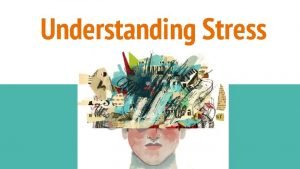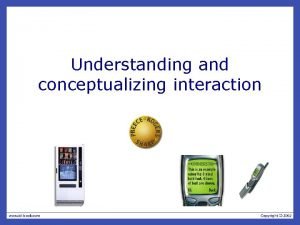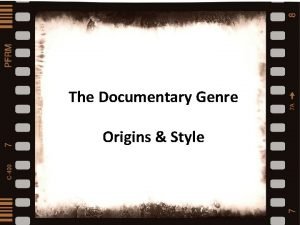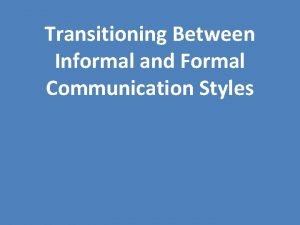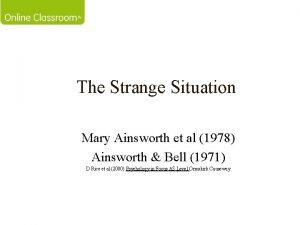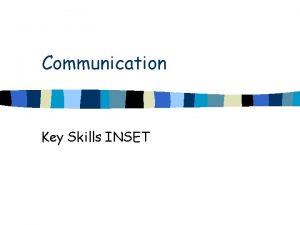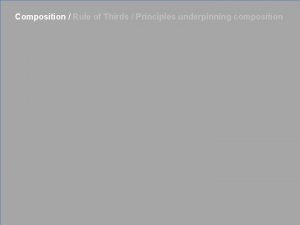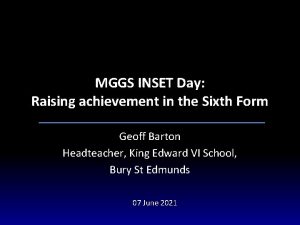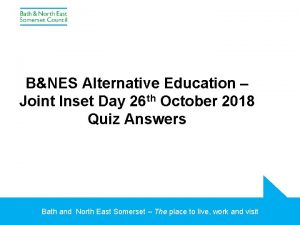Composition Inset Day LPOLuke Styles My approach to




































- Slides: 36

Composition Inset Day LPO/Luke Styles

My approach to teaching composition • Exercises that turn into pieces. • Exercises that provide the foundation for pieces or give the necessary techniques for composition.

Melody • Try and get students beyond short 2 -4 bar phrases and to start thinking of counterpoint and polyphony. • Listening examples, practically any Bach.

Melody - Task • Aim: Imposing boundaries and limitations to help students go beyond symmetrical short phrases that make the music sound short of breath and repetitive.

Melody - Task • Compose a 2 part piece where you set a scale (5 -7 notes).

Melody - Task • Compose a 2 part piece where you set a scale (5 -7 notes). • You can also set the note values (only minims and crotchets etc).

Melody - Task • Compose a 2 part piece where you set a scale (5 -7 notes). • You can also set the note values (only minims and crotchets etc). • One part moves while the other rests.

Melody - Task • Compose a 2 part piece where you set a scale (5 -7 notes). • You can also set the note values (only minims and crotchets etc). • One part moves while the other rests. • Phrases are given a minimum number of beats to break the 2 -4 bar temptation.

Melody - Task • Compose a 2 part piece where you set a scale (5 -7 notes). • You can also set the note values (only minims and crotchets etc). • One part moves while the other rests. • Phrases are given a minimum number of beats to break the 2 -4 bar temptation. • The melodies should articulate different root notes (thus introducing modality).

Orchestration • My thoughts.

Orchestration - Questions • Do you find that students have a working knowledge of many instruments? • What instruments would you suggest they write for?

Orchestration - Registers • Ask them to describe the different registers of the instruments. • Ask them for different registers that would contrast one another. • Ask them to think of registers of 2 instruments that would combine really well. • Ask for 2 examples of three instrument registers that would mix really well.

Orchestrating a Song • Task: For inclusion with voice. • Take a simple song that they can sing and that you have the piano part for. • Get them to arrange the piano part for instruments in the class. Or you arrange it for instruments in the class. • Get them to play around with changing dynamics, articulation, tempo, harmony, modulation etc. • This can be done spontaneously as a group or as a homework exercise.

Orchestrating An. Statt Dass • How does the clarinet sound in relation to the violin and double bass? • What happens when one is marked louder than another? • What happens when one stops playing? Texture? • Arco vs pizz. Tongued vs slurred. Different articulations and dynamics. • Ask them if there is something they would like to try out and get them to experiment with this as a group and as a homework exercise.

Orchestrating Chords • Task: Take the chords that you have come across in class or from earlier exercises and orchestrate them for available instruments bringing out the Dark, light, harsh, high, low etc qualities.

Orchestrating Chords • Task: Take the chords that you have come across in class or from earlier exercises and orchestrate them for available instruments bringing out the Dark, light, harsh, high, low etc qualities. • Orchestrate a chord where each individual instrument can be heard.

Orchestrating Chords • Task: Take the chords that you have come across in class or from earlier exercises and orchestrate them for available instruments bringing out the Dark, light, harsh, high, low etc qualities. • Orchestrate a chord where each individual instrument can be heard. • Take 1 chord and repeat it a number of times orchestrating it differently so it moves from low to high.

Orchestration • Task: orchestrate the Tristan prelude. • A phrase at a time. Bring out the different voices. Making it different each time. • Observe the dynamics. • This may also expose them to some new harmonic ideas and use of chromaticism.

Orchestration - Listening • Pictures at an Exhibition. Mussorgsky vs Ravel. • America the Beautiful arranged by Jaco Pastorius. • Paranoid Android arranged by Brad Mehldau.

Orchestration • Task: take a tune they know (a pop song or folk tune etc) and arrange it to create a different mood from the original. • For instrumental ranges see: Instrumentation and Orchestration, Alfred Blatter (Author) Publisher: Wadsworth Publishing Co Inc; 2 nd Revised edition (31 May 1997). ISBN-10: 0534251870. ISBN-13: 978 -0534251871

Rhythm • Clap the circle.

Rhythm • Notate the group pattern (before the moving).

Rhythm • Notate the group pattern (before the moving). • Compose a clapping piece for two people, using this pattern, demonstrating use of the pattern in prime and retrograde forms with 1 and 2 part passages. Polyphony and unison.

Harmony • Finding the notes

Harmony - Finding the Notes • Play ‘Les Cinq Doigits’ (1922) Andantino by Stravinsky (1882 -1971). • Ask about harmony. Key C Major? Modal? White Note harmony? • With these questions in mind, listen again with the score. Ask how it is put together. Write the 5 note mode on the board. • What makes a mode? Can you think of a 7 note mode (major/minor scale), 5 note (pentatonic), 6 note (whole tone), 8 note (octatonic), 12 note (chromatic).

Harmony - Finding the Notes • Write the mode on the board. • Ask how this could be expressed in number of semi-tones from the bass note i. e. 0, 2, 4, 5, 7. • This is a method of analysing material used in Set Class Theory.

Harmony - Finding the Notes • Creating our own modes: GROUP TASK • To show that notes for a composition can come from anywhere and to acquire the building blocks for chords/a piece.

Harmony - Finding the Notes • We will make 2 modes, from phone numbers, address’ or DOBs.

Harmony - Finding the Notes • We will make 2 modes, from phone numbers, address’ or DOBs. • Play the 2 modes. Ask for impressions of the modes. Comparison to Stravinsky’s modes.

Harmony - Finding the Notes • We will make 2 modes, from phone numbers, address’ or DOBs. • Play the 2 modes. Ask for impressions of the modes. Comparison to Stravinsky’s modes. • FOR STUDENTS: In groups come up with two modes each using addresses/post codes. • Play and explain how you got them.

Harmony - Understanding our Material • Together analyse Stravinsky’s mode in terms of its intervallic content. • C, D, E, F, G = -2 (1), +2 (3), -3 (2), +3 (1), P 4 (2), Tri (0), P 5 (1)

Harmony - Understanding our Material • Together analyse Stravinsky’s mode in terms of its intervallic content, • C, D, E, F, G = -2 (1), +2 (3), -3 (2), +3 (1), P 4 (2), Tri (0), P 5 (1) • What about intervals that are missing? (think about inversions, what new intervals do we get? )

Harmony - Understanding our Material • Task: Compose a single line melody for someone else in the class, use 2 modes, the missing intervals to create contrast and to move/modulate between the modes.

Harmony - Understanding our Material • Task: Compose a single line melody for someone else in the class, use 2 modes, the missing intervals to create contrast and to move/modulate between the modes. • Addition: Try transposing modes to get new modes. • Combining modes together. • Expanding and contracting modes, make all the minor 3 rds major or the minor 2 nds major, etc.

Reflection • Reflect on what we have talked about and come up with one or two new things you might do or focus on with student composers. • It does not have to be something I have suggested.

Thank You
 Inset piece funeral
Inset piece funeral Day 1 day 2 day 3 day 4
Day 1 day 2 day 3 day 4 Day 1 day 2 day 817
Day 1 day 2 day 817 Virtual circuit network
Virtual circuit network Theoretical models of counseling
Theoretical models of counseling Fine grained screening
Fine grained screening Multi approach avoidance conflict
Multi approach avoidance conflict Cognitive approach vs behavioral approach
Cognitive approach vs behavioral approach Process of research definition
Process of research definition Traditional development approach
Traditional development approach Deep learning approach and surface learning approach
Deep learning approach and surface learning approach Schoolmax login
Schoolmax login Oceans apart day after
Oceans apart day after Day to day maintenance
Day to day maintenance Physical science chapter 6 review answers
Physical science chapter 6 review answers Tomorrow i dont know
Tomorrow i dont know Act 2, scene 4 romeo and juliet summary
Act 2, scene 4 romeo and juliet summary Growing day by day
Growing day by day Define seed dormancy
Define seed dormancy Conclusion of seeds
Conclusion of seeds Geotropism
Geotropism I live for jesus day after day
I live for jesus day after day Glorious day one day when heaven
Glorious day one day when heaven Day one day one noodle ss2
Day one day one noodle ss2 Afc futsal coaching course level 1
Afc futsal coaching course level 1 Analytical intuitive functional and personal
Analytical intuitive functional and personal Unhelpful thinking styles pdf
Unhelpful thinking styles pdf Conceptual model in hci
Conceptual model in hci Types of poetry that tells a story
Types of poetry that tells a story Genres of documentaries
Genres of documentaries Orange blue green gold personality test printable
Orange blue green gold personality test printable Formal communication style examples
Formal communication style examples Strange situation experiment
Strange situation experiment Walter bleakley
Walter bleakley Vark learning styles fleming 1987
Vark learning styles fleming 1987 Social style expressive
Social style expressive Teaching styles self-assessment tool
Teaching styles self-assessment tool


























